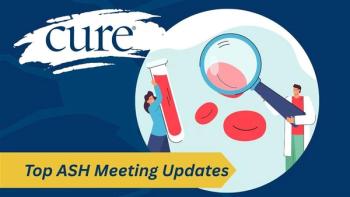
Tagrisso Slows Progression in Non-Small Cell Lung Cancer Subset
A phase 3 study proved that Tagrisso can benefit some patients with NSCLC.
Tagrisso (osimertinib) showed benefit for patients with EGFR T790M-mutant locally-advanced or metastatic non—small cell lung cancer (NSCLC) who progressed on a frontline EGFR TKI. Results were first seen in a phase 2 study, then confirmed in the phase 3 AURA3 study, according to a statement from AstraZeneca, the manufacturer for the EGFR inhibitor.
In the phase 3 study, Tagrisso demonstrated a significant improvement in progression-free survival (PFS) compared with standard platinum-based chemotherapy. Additionally, secondary endpoints of objective response rate (ORR), disease control rate, and duration of response were also improved with Tagrisso versus chemotherapy. Further analyses of the study are ongoing, specifically for overall survival, according to AstraZeneca.
The company plans to present results from the AURA3 trial at an upcoming medical meeting. Findings from the phase 3 trial will serve as confirmatory findings for an accelerated FDA approval received by Tagrisso in November 2015.
“These results confirm Tagrisso as a meaningful alternative to benefit EGFR T790M lung cancer patients," Sean Bohen, executive vice president, Global Medicines Development and chief medical officer at AstraZeneca, said in a statement.
In the open-label study, 419 patients were randomized in a two to one ratio to receive Tagrisso or a platinum-based chemotherapy doublet. Tagrisso (formally AZD9291) was administered once per day orally at 80 mg in a 21-day cycle. The chemotherapy arm included pemetrexed plus carboplatin or pemetrexed plus cisplatin. Pemetrexed was administered at 500 mg/m2, carboplatin was given at a dose of 5 AUC, and cisplatin was administered at 75 mg/m2.
All patients enrolled in the study were chemotherapy naive, with confirmed progression on erlotinib, gefitinib or afatinib. Those who progressed on treatment in the chemotherapy were eligible to cross over to receive Tagrisso; however, if patient's stopped chemotherapy for any reason other than progression, they were not eligible for cross over. If a clinical benefit was still observed, patients were permitted to receive Tagrisso beyond radiographic progression.
The primary endpoint of the study was PFS, which was assessed by blinded independent central review. Response was measured using RECIST v1.1 criteria.
In 2015, Tagrisso was granted an accelerated approval for patients with advanced EGFR T790M-mutant NSCLC following progression on a prior EGFR TKI, based on data from 411 patients in two single-arm studies. Along with Tagrisso, the FDA also approved the cobas EGFR Mutation Test v2 as a companion diagnostic.
In the first study, labeled AURA2, the ORR with Tagrisso was 61 percent in 210 patients with pretreated EGFR T790M-mutant NSCLC. In the second trial, which was an extension to the AURA study, the ORR was 57 percent in 201 patients. In a pooled-analysis of the two studies, the ORR with Tagrisso was 59 percent, with a 12.4-month duration of response.
In February 2016, the European Commission (EC) also granted a conditional marketing authorization to Tagrisso for patients with locally advanced or metastatic EGFR T790M-mutant NSCLC; however, this approval was intended for patients regardless of prior treatment with EGFR TKI. The EC noted in its approval that the EGFR T790M alteration could be detected using either tumor or blood testing.
The EC approval was based on data from two phase 2 studies and one phase 1 expansion study, which together investigated Tagrisso in 474 patients with NSCLC. In the phase 2 AURA and AURA2 trials, the combined ORR with Tagrisso was 66 percent and median PFS was 11 months. In the third study, the ORR in treatment-naive patients was 75 percent.
In a combined analysis of the 411 patients in both second-line trials, the FDA reported that the most commonly reported all-grade adverse events (AEs) were diarrhea (42 percent), rash (41 percent), dry skin (31 percent), nail toxicity (25 percent), eye disorders (18 percent), nausea (17 percent), decreased appetite (16 percent) and constipation (15 percent). These events were primary grade 1/2, with a low rate of grade 3 or higher AEs. The most common grade 3 or higher AEs were pneumonia (2 percent) and pulmonary embolism (2 percent).
According to AstraZeneca, the safety profile for Tagrisso that was observed in the phase 3 AURA3 study was consistent with expectation set by the earlier studies. Further findings from patient-reported outcomes will be reported from the phase 3 study, as a secondary endpoint.
"The AURA3 results demonstrate the benefits of our science-led approach that enabled the rapid development of Tagrisso as a targeted treatment to address the most common cause of resistance to a first-generation EGFR-TKI for patients with metastatic EGFR-mutant lung cancer," said Bohen. "We remain committed to exploring the potential of Tagrisso to further extend its reach and help meet patient need.”
The time from the start of clinical trials to FDA approval for Tagrisso was just two and a half years. As it was developed, the agent received fast track and breakthrough therapy designations from the FDA, which helped to expedite its approval.
Several clinical trials continue to assess Tagrisso, both as a single agent and in novel combinations. The EGFR inhibitor is being explored with the PD-L1 inhibitor durvalumab, the MEK inhibitor selumetinib, and with the MET inhibitor savolitinib for patients with NSCLC.
A phase 3 study is exploring Tagrisso in the frontline setting following tumor resection, with or without adjuvant chemotherapy (





